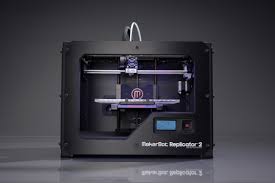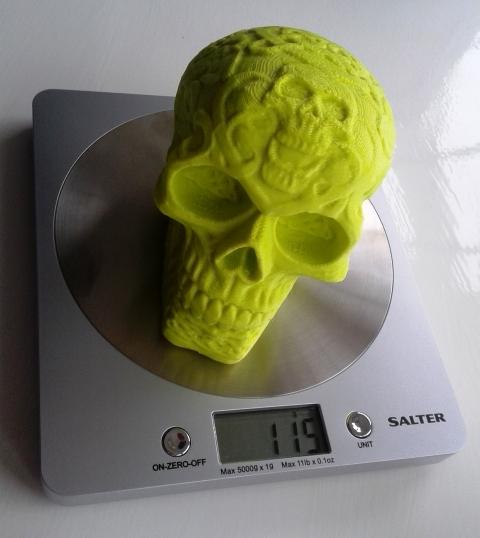 For all the would-be 3D printing enthusiasts, as well as parents out there thinking about wrapping up a 3D printer with a bow during the holidays this year, this article may answer some of the basic questions you have about what you are getting into once the 3D printer has made a place in your home and is busy pumping out prototypes — with a constant need for materials and supplies.
For all the would-be 3D printing enthusiasts, as well as parents out there thinking about wrapping up a 3D printer with a bow during the holidays this year, this article may answer some of the basic questions you have about what you are getting into once the 3D printer has made a place in your home and is busy pumping out prototypes — with a constant need for materials and supplies.
Jason King, 3D printing enthusiast at 3D Print Headquarters, took on the challenge of outlining the costs of 3D printing after being asked the question by some other users.
It’s easy to become immersed in a project and either have no bottom line to begin with, or allow it to be easily forgotten once inspiration, creation, and production mode strike. Keeping in mind that outlay for design and production is not free, a budget is important — and the term ‘starving artist’ can be all too true a reality for many creative types who see a concept that needs to be brought to fruition, but sometimes find balancing a checkbook to be lower on the list of priorities. This is definitely a conversation that needs to be had if you are thinking about financing a child or partner in their 3D printing endeavors.
So whether you are setting off on a personal and creative venture or a serious business venture, here are some very helpful — and pleasing — guidelines to help you estimate what you may or may not be getting yourself into.
 King used some set variables for his estimations, going on his own purchases and experience, which are appropriate for the average user. He purchased a MakerBot Replicator 2 for £1576 (translating to about $2,465).
King used some set variables for his estimations, going on his own purchases and experience, which are appropriate for the average user. He purchased a MakerBot Replicator 2 for £1576 (translating to about $2,465).
Cost of materials is going to be the central question, as that’s what you will need to feed your addiction once you get going like crazy with 3D printing. A balance has to be considered between filament that’s priced right but will produce quality prints. This was calculated to be a bit more than half of printing costs at 52.48%, with a cost of about $5.34 for materials to make an object that weighs a few ounces. For anyone, this is a helpful figure, if you try to multiply that with how many products you, or a mad young scientist taking over your home basement, may be 3D printing.
Another big question that many folks are concerned about with any item that burns electricity is how much it’s going to affect the power bill on a monthly basis. For this item, power figures in with a figure of 0.6% of your print, so if you have a small operation going on, an expenditure of six cents per project is probably not going to be a problem. With the size we are using as an example, figure you might be running your 3D printer for five or six hours to produce that item.
Other items featured in the expenses are:
- Repairs at about 32 cents per item. This is a realistic concern, as repairs do tend to play into use of this complex machinery. Upgrades are figured into this as well.
- Depreciation at about $3.37 per item. This is based on your printer running for five years, so is probably a conservative number, but depreciation is something many people do like to factor in.
- Price of failure at 9.09% with a tag of approximately 92 cents. It’s nice to know you can fail for under a dollar, but that could certainly add up as you hone your skills.
- Other consumables added in at about 1.5%, like tape, grease, knives, and items used for finishing.
 While King used British pounds to calculate his figures, with currency translated to US, one product weighing roughly 3.5 ounces would cost you about $10 US to print, with just about every cost you could think of to include, not withstanding software (usually free) and your own time (that one depends!).
While King used British pounds to calculate his figures, with currency translated to US, one product weighing roughly 3.5 ounces would cost you about $10 US to print, with just about every cost you could think of to include, not withstanding software (usually free) and your own time (that one depends!).
These figures would leave room for cutting back on expenses like the obvious, in buying a less expensive printer, using ‘smart supports’ and as little fill as possible to cut back on filament use, and getting educated and precise before you print, eliminating as many epic fails as possible.
Are you looking into the expenses of buying a 3D printer and beginning to make your own designs? If you are already 3D printing, how do these expenses fall in line with your own calculations? Tell us about it, along with any ideas for saving, in the Can I Really Afford to Get into 3D Printing? forum over at 3DPB.com.
[Source: 3dprinthq.com]Subscribe to Our Email Newsletter
Stay up-to-date on all the latest news from the 3D printing industry and receive information and offers from third party vendors.
Print Services
Upload your 3D Models and get them printed quickly and efficiently.
You May Also Like
The Dental Additive Manufacturing Market Could Nearly Double by 2033, According to AM Research
According to an AM Research report from 2024, the medical device industry, specifically in dentistry, prosthetics, and audiology, is expected to see significant growth as these segments continue to benefit from...
Heating Up: 3D Systems’ Scott Green Discusses 3D Printing’s Potential in the Data Center Industry
The relentless rise of NVIDIA, the steadily increasing pledges of major private and public investments in national infrastructure projects around the world, and the general cultural obsession with AI have...
AM Research Webinar Explores Continuum’s Sustainable Metal Additive Manufacturing Powders
Metal additive manufacturing (AM) powder supplier Continuum Powders is working to develop solutions that empower industries to reduce waste and optimize their resources. An independent life cycle assessment (LCA) of...
3D Printed Footwear Startup Koobz Lands $7.2M in Seed Round
California-based Koobz is focused on reshoring the U.S. footwear supply chain with advanced manufacturing processes, including 3D printing. The startup just announced that it has added $6 million to its...
































